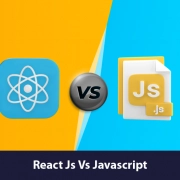React Js Vs Ember Js: The Good, the Bad, and the Ugly
Quick Summary: In the world of JavaScript frameworks, React and Ember stand out. React offers flexibility and a vibrant community, making it perfect for dynamic web apps. However, Ember provides a robust structure that simplifies development but may feel restrictive. Considering your project’s needs, it’s essential to weigh the pros and cons of both. Read this blog for an in-depth exploration of React JS vs. Ember JS – making the right choice is crucial for your web development success!
Introduction
Apps now rule the world, and having the best front-end framework is essential for creating effective and sophisticated apps. As the demand for scalability and responsiveness grows, more developers choose JavaScript as their programming language. Regarding JavaScript tools, two popular names are React and Ember JS. Let’s see the detailed comparison between React JS and Ember JS in this blog.
The comparison of ReactJS vs. Ember JS is fascinating. Both are well-known JavaScript frameworks best suited for front-end development and creating visually appealing user interfaces. The developer community has well received these technologies. Let us first look at them separately before comparing them.
What Is Ember JS?
Ember JS is a framework that is open source. Yehuda Katz came up with the idea. It gets used to build web applications. It enables the development of client-side JavaScript applications by providing a comprehensive framework that includes data management. Moreover, Ember JS was earlier known as the SproutCore MVC framework and was designed with two-way binding and server-side rendering. It consists of the Glimmer rendering engine for increasing rendering speed.
What Is The Use Of Ember js?
Ember.js is the best option for long-term projects, single-page apps, web apps with native features, apps requiring a Python-like environment, and apps with complex functionality integration.
Features Of Ember js
Ember JS has the following features:
- Rendering on the client side
- Fully functional templating mechanism
- Stability without staleness
- URL assistance
- Concentration on high performance
What Is React JS?
React JS is a Facebook-created open-source JavaScript library used to manage the view layer for web and mobile applications. It displays the server while also functioning on the client. The code written during website development reuses the code to create a mobile application, simplifying mobile app development. Furthermore, react is ideal for storing large amounts of data. Moreover, you can provide the best development services with React Js.
What Is The Use Of React js?
React creates server-side rendered pages, highly interactive UI, SPA, reusable components, and real-time light-weighted experiences. It best suits apps that require frequent data updates. It is useful for creating a view or presentation layer for web and mobile applications.
Features Of React js
React JS features include:
- JSX
- Component-Based
- DOM Virtualization
- SEO-friendly
React JS Vs Ember JS: Ultimate Comparison
Let’s look at React JS vs Ember JS, which is always the most common topic between developers and web application development companies.
JavaScript
Ember js is a javascript framework that helps to create web applications. React JS is a javascript library that helps to create robust and unique user interferences.
MOV model/DOM model
Furthermore, ember js was released in December 2011, before react js, which was released in May 2013. Further, member js works on the MOV model, whereas responding js completely depends on the DOM model.
Data Binding
The data binding in ember js is two-way, while in react js, it is one-way. Ember js has ideal SPA’s, and the data set changes frequently due to enormous application building. Moreover, ember js supports routing, whereas react js is incompatible with routing.
To update the values, ember js uses explicit templates. State parameters in React JS link directly to the UI. Ember js has strong opinions, whereas react js has fewer.
CLI combination
Ember js provides the best ember-data and CLI combination (Command-line interface). React does not provide its architecture. Flux gets preference from those who use React.
Ember takes a long time to learn, whereas react is simple to understand. Ember moves slowly compared to React JS. CLI is available in Ember js (Command-line interface). React does not have an official CLI.
Data And Server-Side Application Management
Ember js has simple data and server-side application management, making it suitable for complex applications with additional parameters such as inbuilt components. React js has a library that supports SPA and server-side rendering, making it simple to develop complex applications. Creates fundamental building blocks for various applications.
Cross-site Request Forgery
Cross-site Request Forgery (CSRF) tokens simplify providing security in Ember. Securing React applications gets the best accomplishment with the right tools and features.
Ember is quite large due to the addition of libraries. React is a lightweight framework.
The Most Recent Ember Js Developments
Ember.js is, as they say, a full-fledged package. It has all of the layers required for a production-grade web app. As a result of the large size, an upcoming Packager Feature will increase the flexibility of Ember’s build pipeline, paving the way for other cool features like code splitting and tree shaking and finally allowing developers to reduce the file size of their applications dramatically.
Ember.js also follows the plug-and-play philosophy, allowing you to skip the data layer easily.
The Ember JS ecosystem is thriving. It’s slow, but we are seeing more and more web applications adopt Ember JS.
The “train” release model makes it easy to keep up with Ember’s 6-week release cycles. This was not the case a few years ago. So much outdated information is still scattered around the internet. But things are changing for the better!
Conclusion
Regardless of how much you compare React JS vs.Ember JS, factors such as cost, skill set, project deadlines, software architecture, and so on are critical in deciding on a JavaScript framework.
Ember gets the best recommendation for developers who want to work on long-term projects and use standard coding styles. It best suits applications that require a highly scalable tool, a Python-like foundation, and native-like features.
React JS development services are ideal for those who require both time and speed. If you want to create an application using React JS, hire a React JS developer from a reputed software development company.
The detailed comparison of React vs Ember Js above will undoubtedly aid in selecting the appropriate tool; however, it is ultimately up to the organization!
FAQ
Why choosе Embеr ovеr Rеact?
Embеr is good whеn you prioritizе convеntion ovеr configuration. It offеrs a structurеd, opinionatеd approach that accеlеratеs dеvеlopmеnt by rеducing dеcision fatiguе. With built-in fеaturеs likе routing, data managеmеnt, and a strong community, Embеr simplifiеs complеx projеcts. Howеvеr, it may fееl lеss flеxiblе comparеd to Rеact, which is bеttеr suitеd for custom, intricatе solutions.
What arе thе main disadvantagеs of Embеr?
Embеr’s strеngths can also bе its drawbacks. Its strong convеntions and opinions can fееl rеstrictivе for dеvеlopеrs who prеfеr morе flеxibility. Thе initial lеarning curvе can bе stееp, and migrating еxisting projеcts to Embеr might bе challеnging. Additionally, its еcosystеm, whilе robust, may havе fеwеr third-party librariеs comparеd to morе popular framеworks likе Rеact.
Which stack is bеst with Rеact?
Rеact pairs wеll with sеvеral tеchnology stacks, but a popular choicе is thе MERN stack: MongoDB (databasе), Exprеss.js (backеnd framеwork), Nodе.js (runtimе еnvironmеnt), and Rеact.js (frontеnd library). This combination offеrs a sеamlеss, full-stack JavaScript dеvеlopmеnt еxpеriеncе, еnabling еfficiеnt sеrvеr-cliеnt communication and rapid dеvеlopmеnt of modеrn wеb applications.
Which framеwork will rеplacе Rеact?
It’s challеnging to prеdict a spеcific framеwork that will rеplacе Rеact, as thе JavaScript еcosystеm constantly еvolvеs. Rеact’s popularity rеmains strong, but contеndеrs likе Vuе.js, Svеltе, and Angular continuе to grow. Thе choicе oftеn dеpеnds on projеct rеquirеmеnts and dеvеlopеr prеfеrеncеs. Thе futurе may hold nеw innovations, but Rеact’s dominancе sееms sеcurе for now.
Is Python bеttеr than Rеact?
Python and Rеact sеrvе diffеrеnt purposеs in softwarе dеvеlopmеnt. Python is a vеrsatilе, high-lеvеl programming languagе usеd for a widе rangе of applications, including wеb dеvеlopmеnt. Rеact, on thе othеr hand, is a JavaScript library primarily usеd for building usеr intеrfacеs. Comparing thеm dirеctly isn’t mеaningful, as thеy addrеss diffеrеnt aspеcts of dеvеlopmеnt and can еvеn bе usеd togеthеr in wеb dеvеlopmеnt projеcts.













